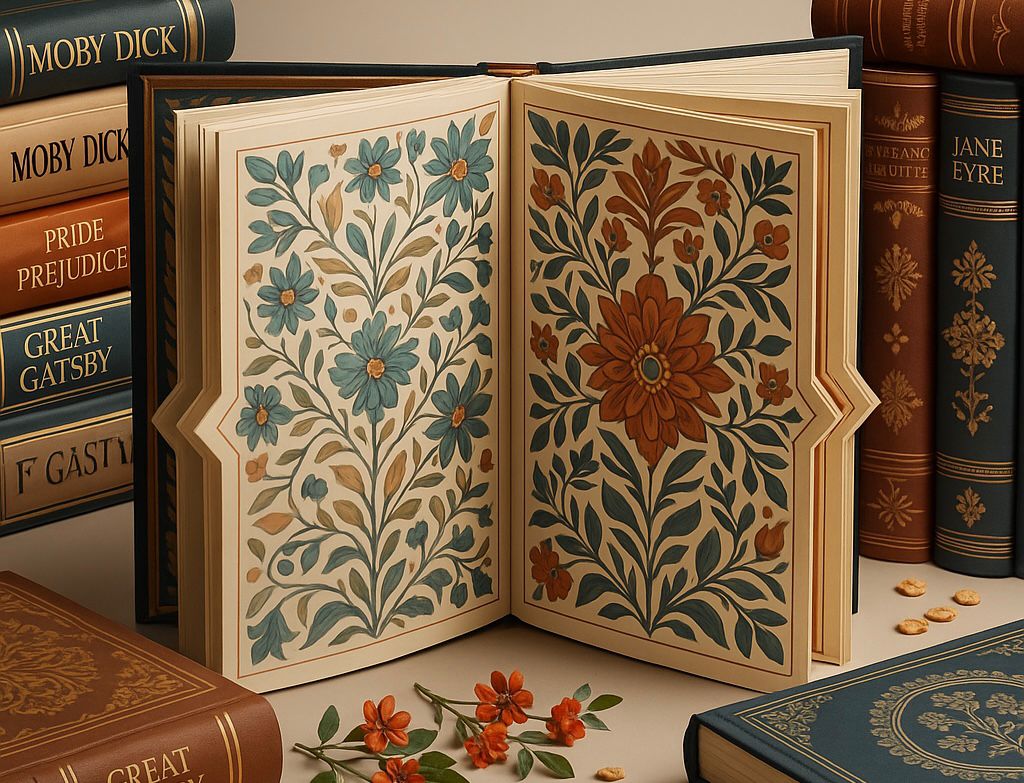Designers Speak: The Art of Interpretation
BY MEGHA ANN MATHEW
23 July, 2025

“Design is translation. The designer takes an author’s emotion and gives it form through colour, contrast, and composition. Sometimes, it takes a fight to get it right. But when it clicks, it doesn’t just reflect the text—it elevates it.”
In many ways, the cover is the book’s first storyteller.

Na Kim
Globally, cover designers like Na Kim, who redefined Penguin Classics with her clean, illustrative style, have become design icons. Her covers don’t merely wrap books; they reframe them, often inviting new audiences to engage with old texts. In the digital age, cover reveals have become standalone publicity events. They build anticipation, generate buzz across Bookstagram, and even trend on Twitter.
Today, artists are being credited and celebrated. We often see readers tagging illustrators alongside authors, and in some cases, picking up books specifically because the design moved them emotionally or sparked curiosity. And this shift is not limited to literary fiction or high-end titles. Even regional translations, debut poetry collections, and experimental works are now getting bespoke cover treatment. Designers are being looped in earlier during the editorial process, often reading manuscripts or concept notes before the visual direction is set. It’s a collaborative, layered process—sometimes messy, always rewarding.

In India, this transformation is especially significant. For decades, Indian book covers remained largely functional, often templated or outsourced with minimal creative input. But that’s changing. Designers like Pinaki De, Priya Kuriyan, Bonita Vaz-Shimray, and Gunjan Ahlawat are now at the forefront of India’s design renaissance. Their work is increasingly recognised not just for visual appeal, but for how it amplifies the literary voice.
These designers are also vocal about the politics of representation, visual language, and creative agency. Many use social media to share process notes, challenges with publishers, and thoughts on Indian aesthetics in a global market. Their engagement is building a new kind of literacy among readers, one that understands design not as secondary, but integral to storytelling.
Designers today navigate a delicate balance: staying true to a book’s soul while creating an image that stops someone mid-scroll. That’s no small task. But when it works, when the tone, typeface, colour, and composition speak in harmony, the result is unforgettable. A great cover is no longer a quiet introduction; it’s a conversation starter, a statement, sometimes even a protest.

The shortlist of the Oxford Bookstore Book Cover Prize
The broader Indian publishing ecosystem is catching up, too. New awards, like the Oxford Bookstore Book Cover Prize, are recognising excellence in design. Independent presses like Zubaan, Yoda, and Seagull are consistently pushing the envelope. Bookstores are curating titles based on visual themes. Even libraries are paying attention to cover appeal as part of collection development.
And that’s what makes this era in Indian publishing so exciting. As readers become more design-conscious and authors more open to visual experimentation, cover designers are stepping into their rightful place—not at the margins, but at the heart of the storytelling process.
Looking Ahead: Visual Storytelling as a Strategy
For Indian publishers today, investing in design is no longer an indulgence—it’s a strategic necessity. As books jostle for attention in a content-saturated world, cover design has become one of the most important tools in a publisher’s arsenal. Whether it’s to stand out on a crowded shelf, capture attention in a digital scroll, or resonate with readers who see books as personal expressions of taste and identity, design plays a decisive role in discovery and desirability.
We’re witnessing a new era of visual literacy, where readers are not just reading more, but also looking more. With the rise of Bookstagram, YouTube reviews, Pinterest boards, and aesthetic-driven online shopping, books are increasingly judged by their jackets and rightly so. A well-designed cover signals quality, relevance, and care. It communicates mood, tone, and theme in a single glance. It’s a silent yet persuasive ambassador for what lies inside.
But this is not merely about decoration. As bestselling author Elena Ferrante’s experience demonstrates, a poor design choice can actually hurt a book’s performance. When her novel The Lying Life of Adults was released, many online users expressed reluctance to buy it simply because of what they called its “ugly” cover. The backlash was swift and widely circulated, proving that readers expect visual storytelling to match the literary depth. A weak or tone-deaf design is no longer excusable, especially when readers treat books as lifestyle objects, display pieces, and cultural signals.
In that sense, books today are more than content, they’re objects of meaning. A thoughtfully designed cover can become part of someone’s bookshelf aesthetic, their Instagram feed, and even their identity. That’s why publishers like us at Magic Moon are embracing design not as a finishing touch, but as the starting point.

At Magic Moon, we view this as an invitation to elevate publishing into a form of multidisciplinary art. Our recent projects, like Derrida in JNU or Punarudhanam, reflect our commitment to design that’s meaningful, original, and culturally resonant. Whether it’s working with emerging illustrators or integrating traditional motifs in new ways, our jackets are not just sleeves. They are statements. And increasingly, they are how new readers are finding us.
And so, if you’re a reader, a designer, a collector, or simply someone who appreciates beauty in everyday objects, pay attention to the covers. They’re not just inviting you to enter the book. They’re also inviting you to experience the book as art, as culture, as identity.
At Magic Moon, we’re making beautiful, thoughtful, and intentional books. And we’re proud to be part of a generation of publishers where the cover doesn’t just speak, it sings.
